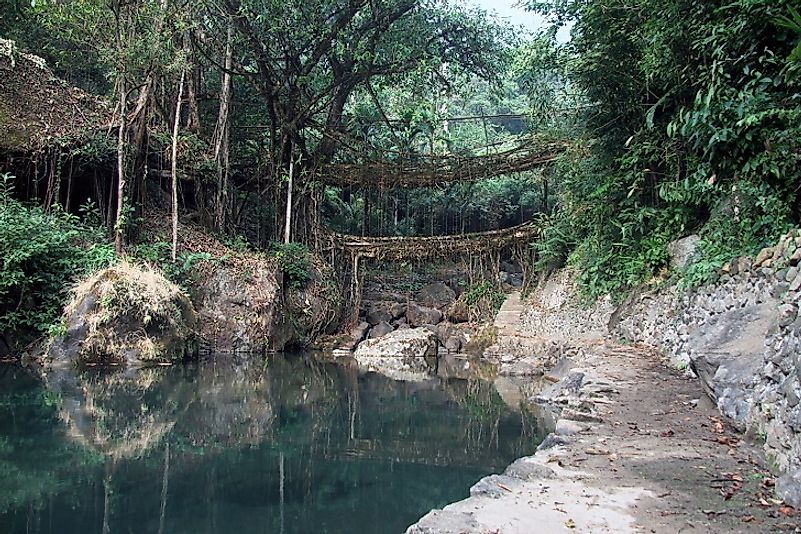Did You Know That There Are Bridges In India "Grown" From Tree Roots?

In all places around the world, bridges are usually built using concrete, steel, or other non-living building materials. Most of us are also familiar with wooden or rope bridges. However, in the north-eastern Indian State of Meghalaya (meaning the abode of the clouds), many of the bridges are made of living plants, blending perfectly well with the surrounding lush green landscape. These living root bridges are built by the locals of the region, the people from the Khasi and Jaintia tribes, who inhabit the hilly terrain of the Shillong Plateau. The bridges take a long time of 15 to 30 years to grow and may stretch for distances of more than 100 feet. The locals first place bamboo scaffolds or hollowed-out trunks of Areca nut trees across rivers and streams to allow the aerial roots of the local fig-trees, especially the Ficus elastica, to grow horizontally from opposite ends of the river or stream until they meet each other. These bio-engineering wonders can carry nearly 35 people at a time, and have a lifespan of 500 years, more than those of modern-day sophisticated bridges. The famous Umshiang Double Decker root bridge in Nongriat village near Cherrapunjee is around 200 years old. Also, unlike most modern-day bridges, the living root bridges naturally grow stronger with time, and thus do not need regular maintenance and repair work.
4. Historical Role
The living root bridges were born as a result of innovative thinking by the tribals. The entire state of Meghalaya is full of lush and verdurous mountains and tropical forests. During the monsoon season, which usually lasts from June to September, low-flowing rivers and streams of the region become wild, raging water flows with strong currents that are impossible to cross by foot. For a long time, the inhabitants of the mountains tried to devise ways to overcome the issues of crossing such speedy rivers and streams and started building bridges out of bamboo over these streams and rivers. However, bamboo bridges were not strong enough and easily rotted and collapsed, leaving the tribal peoples there stranded. Then, the Khasi elders devised the grand new plan of building the living root bridges. They decided to guide the strong rubber tree roots across the river banks until their ends would meet somewhere in the middle. The roots gradually grew longer and stronger, intertwining together in a manner that provided stability to the bridge.
3. Significance to Tourists and Locals
Today, a large number of tourists visit the picturesque Meghalayan hills and forests to experience a walk on these eco-friendly living bridges. Some of the most famous root bridges of the region include the Umshiang Double Decker Root Bridge, the Ummunoi Root Bridges, the Ritymmen Root Bridge, the Umkar Root Bridge, and the Mawsaw Root Bridge. These tourist visitations support the local economy. The living root bridges of Meghalaya have been further popularized by several international travel publications, attracting more and more people to the region to see these tribal- and nature-engineered architectural wonders for themselves.
2. Root Bridge Safety
The living root bridges of Meghalaya are a perfect blend of nature's and man’s ingenious accomplishments. There is little concern regarding the safety of these bridges which grow sturdier with time. It is, however, important to maintain the local rules and regulations, and ensure that the carrying capacity of the bridge is not violated.
1. More Root Bridges To Come?
Today, the lure of building bridges faster using rope, steel, or concrete shifts the attention away from the living root bridges. Most of the new bridges built in the region today are thus built using modern technology. However, some locals still work dedicatedly to protect the old root bridges in the region against any forms of exploitation. There are also some plans to build new living root bridges in the region. In the end, it becomes clear that even in this modern-day-world of engineering marvels, these tribesmen-built, living, breathing bridges will never fail to fascinate us with their uniqueness and astounding beauty.











